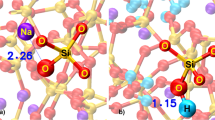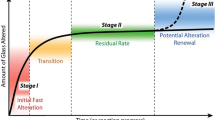Abstract
Controversy continues over the mechanism of the aqueous corrosion of silicate glasses, largely because the processes by which the superficial hydrated layer is formed have not been clearly identified1. Two alternative models are current. One view2–4 is that mobile ions in the glass network (such as Na+, Li+ and K+) are exchanged with hydrogen ions (such as H+ and H3O+) and even H2O in the solution5; the other is that the hydrated layer results from the re-precipitation from solution of dissolved network material6–12. The first model is thought appropriate for simple man-made glasses and the second for more complex and natural glasses. We report here an optical and scanning electron microscope study of the corrosion of various borosilicate glasses irradiated by fission fragments. For all glass-solution combinations studied, we find that the hydrated layer embodies relics of the fission tracks, suggesting that this layer is mainly formed by in situ replacement, but in some cases a step re-precipitation is also apparent.
This is a preview of subscription content, access via your institution
Access options
Subscribe to this journal
Receive 51 print issues and online access
$199.00 per year
only $3.90 per issue
Buy this article
- Purchase on SpringerLink
- Instant access to full article PDF
Prices may be subject to local taxes which are calculated during checkout
Similar content being viewed by others
References
Scholtze, H. J. non-cryst. Solids 52, 91–103 (1982).
Doremus, R. H. J. non-cryst. Solids 19, 137–144 (1975).
Lanford, W. A., Davis, K., Lamarche, P., Laursen, T. & Groleau, R. J. non-cryst. Solids 33, 249–266 (1979).
Smit, W., Stein, H. N. J. non-cryst. Solids 34, 357–370 (1979).
Smets, B. M. J., Lommen, T. P. A. Phys. Chem. Glasses 24, 35–36 (1983).
Nogues, J.-L. thesis, Univ. Montpellier (1984).
Crovisier, J.-L., Fritz, B., Grambow, B. & Eberhart, J.-P. MRS Proc. Symp. Scientific Basis of Nuclear Waste Management, Stockholm, September 1985 (North-Holland, Amsterdam, in the press).
Lutze, W., Malow, G., Ewing, R. C., Jercinovic, M. J. & Keil, K. Nature 314, 252–255 (1985).
Crovisier, J.-L., Thomassin, J.-H., Juteau, T. & Eberhart, J.-P. Geochim. cosmochim. Acta 47, 377–387 (1983).
Grambow, B. MRS Proc. 11, 93–102 (1983).
Bates, J. K., Jardine, L. J. & Steindler, M. J. Science 218, 51–54 (1982).
Thomassin, J.-H. thesis, Univ. Orléans (1984).
Fleischer, R. L., Price, P. B. & Walker, R. M. Nuclear Tracks in Solids (University of California, 1975).
Smets, B. M. J., Lommen, T. P. A. Phys. Chem. Glasses 23(3), 83–87 (1982).
Della Mea, G., Dran, J.-C., Petit, J.-C., Bezzon, G. & Rossi-Alvarez, C. Nucl. Instrum. Meth. 218, 493–499 (1983).
Crank, F. The Mathematics of Diffusion (University of Oxford Press, 1978).
Petit, J.-C., Langevin, Y., Lameille, J.-M. & Dran, J.-C. MRS Proc. 5, 203–210 (1982).
Lutze, W., Malow, G. & Rabe, H. MRS Proc. 15, 37–45 (1983).
Petit, J.-C. thesis, Univ. Paris, Orsay (1982).
Arnold, G. W., Petit, J.-C. Nucl. Instrum. Meth. 209/210, 1071–1077 (1983).
Author information
Authors and Affiliations
Rights and permissions
About this article
Cite this article
Dran, JC., Petit, JC. & Brousse, C. Mechanism of aqueous dissolution of silicate glasses yielded by fission tracks. Nature 319, 485–487 (1986). https://doi.org/10.1038/319485a0
Received:
Accepted:
Issue date:
DOI: https://doi.org/10.1038/319485a0
This article is cited by
-
Effects of irradiation on the mechanisms controlling the residual rate of an alumino-borosilicate glass
npj Materials Degradation (2022)
-
Aqueous alteration of silicate glass: state of knowledge and perspectives
npj Materials Degradation (2021)
-
Morphological instability of aqueous dissolution of silicate glasses and minerals
npj Materials Degradation (2018)
-
Nonlinear dynamics and instability of aqueous dissolution of silicate glasses and minerals
Scientific Reports (2016)
-
Nanometre-scale evidence for interfacial dissolution–reprecipitation control of silicate glass corrosion
Nature Materials (2015)



